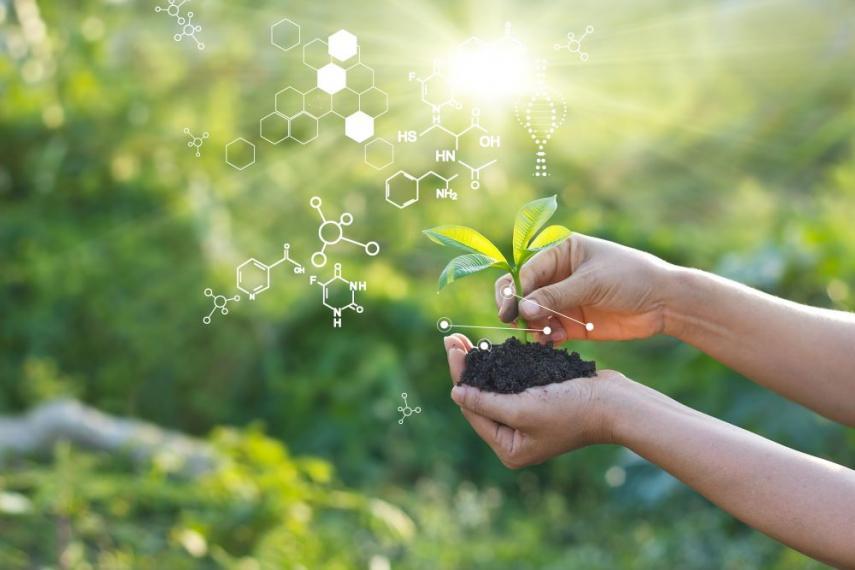Green Science

Research at the University of Guelph’s Electrochemical Technology Centre will help save our planet.
On April 22nd, 2020, the world will observe the 50th anniversary of Earth Day—a modern environmental movement, and a response to a planet in crisis. What better way to mark the occasion than a peek behind the doors of a research centre where investigators are finding innovative solutions to environmental problems: the University of Guelph’s Electrochemical Technology Centre (ETC).
Electrochemistry is the study of electricity and how it relates to chemical reactions. The advanced laboratories of the ETC are home to a wide range of electrochemical instruments that researchers are using in green electrochemistry, which has applications for sustainability.
Prof. Aicheng Chen’s research at the ETC has applications for energy, the environment, food, and medicine.
Take the research being done by Prof. Aicheng Chen, chemistry professor and director of the ETC. Chen has partnered with Zen Graphene Solutions to convert Ontario-sourced graphite—a familiar material found in pencil lead—into a material called graphene. Graphene is one of the thinnest, strongest, and most conductive materials on the planet. Graphene has applications for energy storage in batteries, thermal efficiencies for LED lighting, sensors, and coatings on solar panels.
“We have developed a process that effectively converts graphite to graphene and graphene oxide,” says Chen. “Our patented process will enable the mass production of high-quality graphene-based nanomaterials, which are crucial for commercial applications.”

Prof. Dan Thomas and his group are working to improve fuel cells, which could have a big environmental impact.
The environment is front-of-mind for chemistry professor Daniel Thomas. With M.Sc. student, Ryan Crozier, Thomas is working in the ETC to examine fuel cell design as it applies to “mobile applications”—things that move, such as vehicles.
“Fuel cells used in mobile applications need to be able to respond to constant shifts in power demands—acceleration, braking, idling in traffic, and cruising at highway speeds,” says Thomas. “Our work is part of a collaboration between six research groups in Chemistry and Engineering to provide a sustainable alternative to combustion engines.”

Prof. Khashayar Ghandi’s research will help us unlock the green potential of our earth’s natural resources.
Meanwhile, chemistry professor Khashayar Ghandi is conducting research on material science with energy and health applications.
“By studying the chemical reactions and electronic structure of nanomaterials in clays we have uncovered its important potential for capturing carbon dioxide, which can be transformed to create more sustainable industry products.”
Ghandi’s team also developed the first ever solid-state biosensor for detecting and measuring pathogens in the environment such as bacteria, fungi, and viruses—important work for understanding environmental influences on human health.

Prof. John Dutcher is partnering with industry to reduce plastic waste.
Finally, physics professor John Dutcher is examining chemical changes that occur within plastic pipes commonly used for water lines, in partnership with a Calgary-based company PexCor Manufacturing Inc.
“We are examining the pipe aging process to extend their lifespan and reduce waste,” says Dutcher. “It was one of my students, Melanie Hiles, who brought the idea of implementing machine learning techniques for this research.”
“Our team at the ETC is diverse and multidisciplinary,” says Prof. Chen. “We collaborate with members of our student chapter, industry partners, and other U of G centres like the Centre for Sustainable Nanomaterials Innovation (CESNI). Together we share collective goals: to collaborate, to train future scientists, and to conduct research that helps our world.”
The work highlighted in this article was supported by the Canada Foundation for Innovation, the Natural Sciences and Engineering Research Council of Canada, the Ontario Centres of Excellence, and the Ontario Research Fund.
A. Chen holds a Tier 1 Canada Research Chair in Electrochemistry and Nanoscience.
J. Dutcher holds a Tier 1 Canada Research Chair in Soft Matter and Biological Physics
Read More about the ETC Research:
Prof. A. Chen:
Chen A, Sidhureddy B, Thiruppathi AR. Synthesis of fluorinated graphene oxide for electrochemical applications. United States patent US 10,556,798. 2020 Feb 11.
Hossain MN, Chen S, Chen A. Thermal-assisted synthesis of unique Cu nanodendrites for the efficient electrochemical reduction of CO2. Appl. Catal. B: Environ. 2019 Dec 15. doi: 10.1016/j.apcatb.2019.118096.
Sidhureddy B, Prins S, Wen J, Thiruppathi AR, Govindhan M, Chen A. Synthesis and electrochemical study of mesoporous nickel-cobalt oxides for efficient oxygen reduction. ACS Appl. Mater. Interfaces. 2019 May 22. doi: 10.1021/acsami.8b22351.
Prof. D. Thomas:
Prof. K. Ghandi:
Ghandi K, Landry C, Du T, Lainé M, Saúl A, Le Caër S. Influence of confinement on free radical chemistry in layered nanostructures. Sci Rep. 2019 Nov 20. doi: 10.1038/s41598-019-52662-z.
Landry C, Morrison AH, Ghandi K. Application of muon and other complementary radiation techniques to study interaction of radiation with nanostructures. Radiat. Phys. Chem. 2020 Mar 18. doi: 10.1016/j.radphyschem.2020.108881.
Landry C., Burns, F, Baerlocher, F., Ghandi, K. Novel Solid‐State Microbial Sensors Based on ZnO Nanorod Arrays. Adv. Funct. Mater. 2018 May 9. doi: 10.1002/adfm.201706309. Also see video abstract.
Prof. J. Dutcher:
Hiles M, Grossutti M, Dutcher JR. Classifying formulations of crosslinked polyethylene pipe by applying machine‐learning concepts to infrared spectra - Hiles - 2019 - Journal of Polymer Science Part B: Polymer Physics - Wiley Online Library J. Polym. Sci. Part B: Polym. Phys. 2019 Sep 15. doi: 10.1002/polb.24837